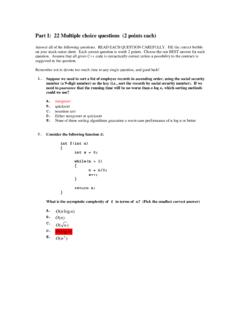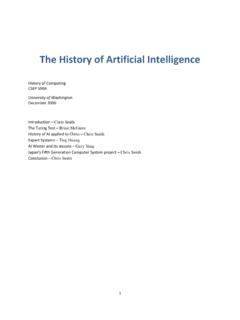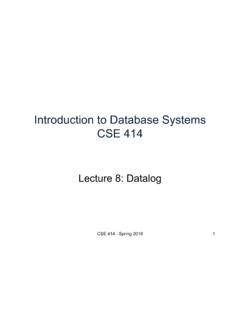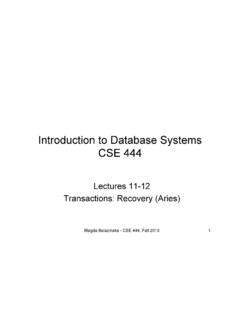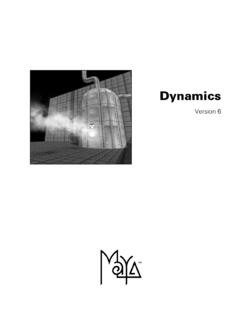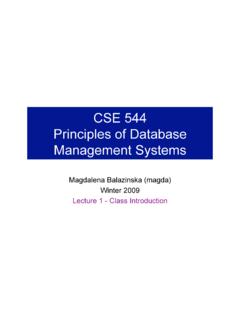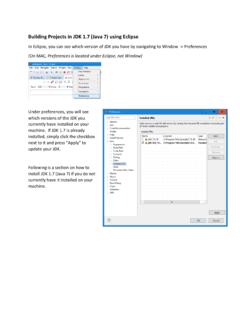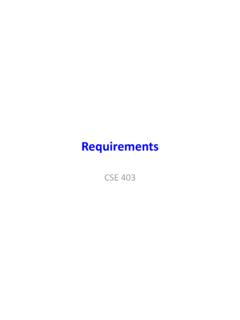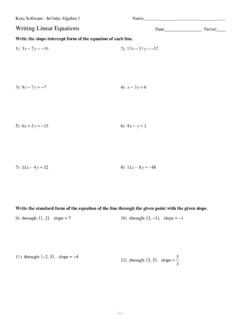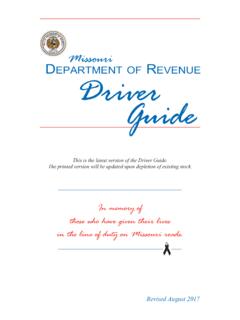Transcription of 2’s Complement and Floating-Point - University of Washington
1 2 s Complement and Floating-PointCSE 351 Section 3 Two s Complement An n-bit, two s Complement number can represent the range [ 2 1, 2 1 1]. Note the asymmetry of this range about 0 there s one more negative number than positive Note what happens when you overflow4-bit two s Complement rangeUnderstanding Two s Complement An easier way to find the decimal value of a two s Complement number: ~x + 1 = -x We can rewrite this as x = ~(-x -1), subtract 1 from the given number, and flip the bits to get the positive portion of the number. Example: 0b11010110 Subtract 1: 0b11010110-1 = 0b11010101 Flip the bits: ~0b11010101 = 0b00101010 Convert to decimal:0b00101010 = (32+8+2)10= 4210 Multiply by negative one, s Complement : numbers to binary 0xAB = 0b10101011 1710= x | y 0000.
2 1010 1011| 0000 .. 0001 0001--------------------0000 .. 1011 1011 ~(x | y) (flip the bits)~ 0000 0000 0000 0000 0000 0000 1011 1011------------------------------------ -----1111 1111 1111 1111 1111 1111 0100 0100int x = 0xAB;int y = 17;int z = 5;int result = ~(x | y) + z;What is the value of result in decimal?Two s Complement : ~(x | y) + z You can either convert to decimal before or after adding z 1710= 0b00010001 Convert111111111111111111111111010001002 to decimal(hint: -x= ~x+ 1) ~111111111111111111111111010001002 = 0000000000000000000000000101110112 ~ + 1 = -x = x= int x = 0xAB;int y = 17;int z = 5;int result = ~(x | y) + z;What is the value of result in decimal?Floating Point value = (-1)S * M* 2E Numerical Form Sign bit sdetermines whether number is negative or positive Significand (mantissa) Mnormally a fractional value in range [ , ) Exponent Eweights value by a (possibly negative) power of two Representation in Memory MSB s is sign bit s expfield encodes E(but is not equal to E) remember the bias Fracfield encodes M(but is not equal to M)sexpmantFloating Point value = (-1)S * M* 2E Value: 1 Mantissa 2 Exponent Bit Fields: (-1)S 2(E+bias) Bias Read exponent as unsigned, but with bias of (2w-1-1) = 127 Representable exponents roughly positive and negative Exponent 0 (Exp= 0) is represented as E = 0b 0111 1111 Why?]
3 Floating point arithmetic = easier Somewhat compatible with 2 s complementsexpmantFloating Point Exponent overflow yields + or - Floats with value + , - , and NaNcan be used in operations Result usually still + , - , or NaN; sometimes intuitive, sometimes not Floating point ops do not work like real math, due to rounding! Not associative: ( + 1e100) 1e100 != + (1e100 1e100) Not distributive: 100 * ( + ) != 100 * + 100 * Not cumulative Repeatedly adding a very small number to a large one may do nothingsexpmantFloating Point Examples How do you represent in floating point? Sign bit: 1 First the integral part of the value: 1 = 0b1 Now compute the decimal: = Don t need to normalize because it s already in scientific notation: x 20 Exponent: 0 + 127 = 12710= 011111112 Mantissa: 10000000000000000000002 = 1 01111111 10000000000000000000002= 0xBFC00000sexpmant1823 Floating Point Examples How do you represent in floating point?
4 Sign bit: 0 First the integral part of the value: 1 = 0b1 > Don t need to normalize because it s already in scientific notation: x 20 Exponent: 0 + 127 = 12710= 011111112 Mantissa: 000000000000000000000002 = 0 01111111 000000000000000000000002= 0x3F800000sexpmant1823 Floating Point Addition( 1)s1*M1*2E1+ (-1)s2*M2*2E2(Assume E1> E2) Exact Result: ( 1)s*M*2E Sign s, mantissa M: M = M1 + M2, result of signed align & add Exponent E: E1 Fixing If M 2, shift Mright, increment E if M< 1,shift Mleft kpositions, decrement Eby k Overflow if Eout of range Round Mto fit fracprecisionsexpmant1823 What is floating point result of + 0 10000010 0 01111111 10000000000000000000000In scientificnotation: ( x 23) + ( x20) x 20+ x20 Adjustedmantissa: => M = 1011101 Ans: 0 10000010 10111010000000000000000 Floating Point Multiplication( 1)s1*M1*2E1* ( 1)s2*M2*2E2 Exact Result: ( 1)s*M*2E Sign s: s1 ^s2 Mantissa M: M1 *M2 Exponent E.
5 E1 +E2 Fixing If M 2, shift Mright, increment E If Eout of range, overflow Round Mto fit fracprecisionsexpmant1823 What is floating point result of * 0 01111111 0 01111111 00000000000000000000000In scientificnotation: ( x 20) + ( x20) 20* x20------------------------------------- -000000000000000000000000010001100110011 00110011010 Result: x20 Ans: 0 01111111 00011001100110011001101 Floating Point Worksheet
